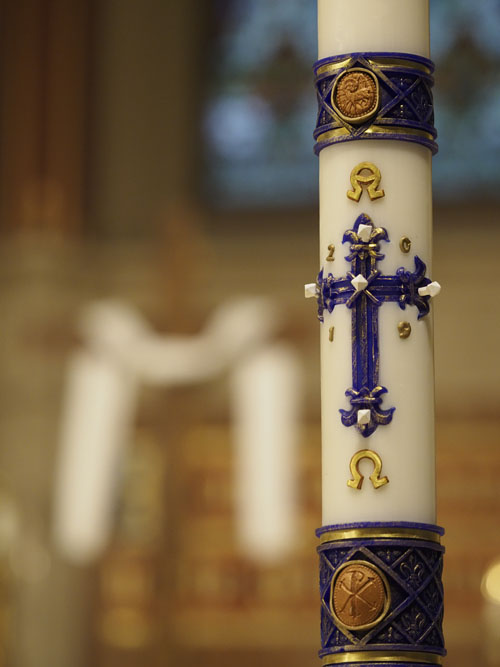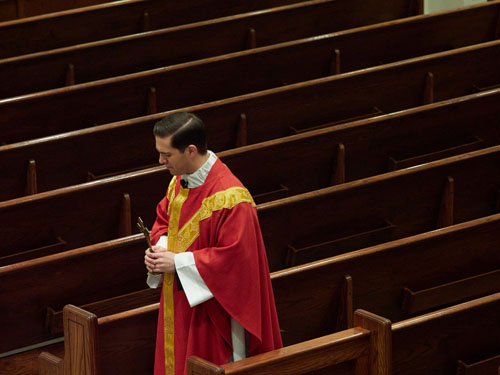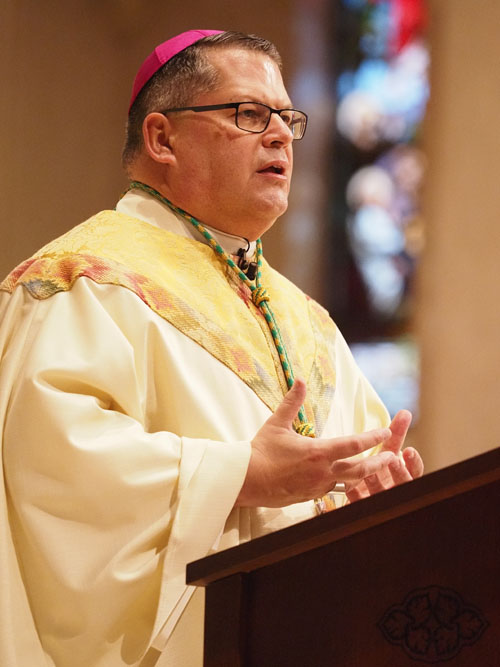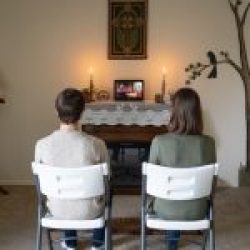By Renée K. Gadoua | Contributing writer, and Katherine Long | Editor
Holy Week 2020 will be remembered as one of history’s most unusual commemorations of Jesus’ death and resurrection. From the Vatican to the seven counties of the Syracuse Diocese, Catholics marked Easter rituals in different — and perhaps uncomfortable — ways amid a global pandemic.
Easter fell just a month after Central New York communities began canceling events, closing schools and businesses, and urging people to stay home to avoid spreading the virus that causes COVID-19. Increasing restrictions followed; Bishop Douglas J. Lucia closed diocesan churches to public Masses on March 16; New York state remains under stay-at-home and social distancing directives until at least April 29.

The Paschal candle is seen at the Cathedral of the Immaculate Conception. (Sun photo | Chuck Wainwright)
The restrictions made for a particularly stark Lent and Holy Week — “unembellished liturgies” that Bishop Lucia called invitations to “strip away a lot of the sentimentality often associated with these days and to see them with the new eyes of faith, hope, and love.”
Bishop Lucia celebrated his first Holy Week as shepherd of the Syracuse Diocese through recorded messages and livestreamed services. On Palm Sunday, he blessed palms no one could bring home out of fear the virus would spread. Holy Thursday’s ritual washing of parishioners’ feet, recalling Jesus’ act of service to his disciples, was omitted.
Pastors and parish staff have moved prayer services and Masses online via YouTube or social media platforms like Facebook and Instagram. With varying expertise levels, pastors sought to preserve their parish’s community and illustrate that church is more than a building.
Holy Week services took place in nearly empty churches. Easter celebrations took place without large family meals, Easter parades, or community egg hunts. But clergy delivered hopeful messages to remind the faithful of Jesus’ love.
“During Holy Week, keep in mind that there is bad news, and there is good news,” Father Thomas Servatius, pastor of Historic Old St. John’s in Utica, said in a video reflection on his parish YouTube channel. “The bad news: There’s no such thing as an Easter without a Good Friday. The good news: There’s no such thing as a Good Friday without an Easter.”
Palm Sunday
Instead of parades and processions with palms symbolizing Jesus’ triumphant entrance into Jerusalem, Catholics marked Palm Sunday April 5 at home, praying alone or watching Mass on TV or online.
Bishop Lucia celebrated Mass in the nearly empty Cathedral of the Immaculate Conception, joined by retired Bishop Robert J. Cunningham and Cathedral rector Msgr. Neal Quartier.
“Certainly our prayers for each one of you and for all our sisters and brothers who these days struggle with the COVID-19 pandemic,” said Bishop Lucia, dressed in red vestments symbolizing Jesus’ blood. “We especially pray for those who are nearest to those undergoing this passion: our doctors, all in health care, along with those who serve our community in different ways. We pray for them that the Lord will continue to give them strength. We pray the Lord will bring healing to those who are ill, comfort to their families. And to those who have died eternal; repose and consolation to their families.”
As morning Mass proceeded, Sunday news shows were reporting updates on the global health crisis. “My God, my God, why have you abandoned me?” the cantor sang.
In the same way that people greeted Jesus asking “Who can this be?” the faithful are facing an unprecedented season, Bishop Lucia said.
“We are invited to be even more keenly aware of our surroundings and who is with us,” he said. “At first glance, we might conclude that we are on our own in a hostile environment and that even God has abandoned us.”
The faithful are asked to carry the cross during Holy Week, “to become true icons to those lives who may seem separated from us, from you and me, by the curtain in illness, by a veil,” he said.
Father Christopher Celentano, pastor of St. Rose of Lima Church in North Syracuse, called Holy Week “an opportunity to enter into this mystery of Christ’s death and resurrection in a totally new way — and perhaps, an even deeper way.”
Father John W. Canorro, pastor of Christ the Good Shepherd in Oswego, also acknowledged the unusual Palm Sunday.
“Like Jesus in the garden, so many of us feel like we’re in the garden right now, too,” he said. “Our faith doesn’t end in the garden. It ends on Sunday morning when the tomb is open.”

Father Christopher Celentano, pastor of St. Rose of Lima in North Syracuse, prays following Mass on Holy Thursday. (Sun photo | Chuck Wainwright)
Holy Thursday
On Holy Thursday, the Church remembers Jesus’ Last Supper and celebrates the institution of the Eucharist and the ordained priesthood.
“On Holy Thursday 2020, gathered in our individual households, in the midst of unsettled times and the threat of death due to the COVID-19 pandemic, we call to mind that Passover meal in the Upper Room in Jerusalem and ask ourselves, ‘Why is this night different from all other nights? What does it have to say to us in our present predicament?’” Bishop Lucia said.
The faithful were reminded that “we as Christ’s family — not in buildings confining but as a family of faith, as Church, which surpasses time and space — dwell now in an upper room filled with light.”
Like Jesus’ first disciples, the faithful are called to follow him, even into the darkness of places like the Garden of Gethsemane, Bishop Lucia said. “Before leaving the Upper Room, Jesus teaches his disciples what weapon they should carry when they go out to confront the dark places of the world: not swords or spears, but love. Love is the counterforce to darkness and chaos….”
Visitation, a Holy Thursday tradition in which the faithful visit Altars of Repose in churches to venerate the Blessed Sacrament, was not possible this year. The diocese organized a virtual pilgrimage, however, providing on its website links to nine parishes livestreaming views of their tabernacles. More than 7,000 visitors particpated, according to Chancellor Danielle Cummings.
Good Friday

Father Christopher R. Seibt, Administrator of Divine Mercy Parish in Central Square and the Mission of Saint Bernadette, makes his way through the church on Good Friday. (Sun photo | Chuck Wainwright)
A few minutes before 3 p.m. April 10, Bishop Lucia carried a wooden cross, covered with a red cloth, to the edge of the altar at the Cathedral. “Behold, behold, the wood of the cross, on which is hung our salvation,” he sang three times during the Veneration of the Cross.
The Good Friday ritual typically draws several hundred worshipers to the Liturgy of the Word, the Veneration of the Cross, and the Service of Communion. By tradition, the altar is bare of flowers, and the crucifix is shrouded with cloth.
As light snow fell, Bishop Lucia delivered a homily that focused on the reading from John’s Gospel, which tells the story of Jesus’ arrest, trial, and execution.
“We hear him cry out his final words: I thirst. It is finished,” he said. “He breathes his last. Sounds like it’s done. It’s over. He hands over his spirit. It looks like death won. The Son of Man hangs on the cross, lifeless.”
His last words — translated to Greek as “tetelestai” — are “the final punctuation on a sentence begun before the beginning,” the bishop said. “Brothers and sisters, as you and I find ourselves on Calvary again today, and in ways we never expected, let us not forget God’s sentence of love on the cross.”
At St. Ambrose in Endicott, Deacon Thomas Harley delivered the homily at the parish’s livestreamed service. “It’s not simply that Jesus died for my sins and yours,” he said. “No. He died to save the world.”
While humans did not create the coronavirus, greed and selfishness may have made it worse, he said, adding, “Fewer people might have been infected if we had more regard for one another at the onset.”
Jesus’ sacrifice, torture, and death are meant to overcome sinfulness. “On Good Friday we kiss the cross because we wish to honor our own Christian mission: To be what we are called to be, human beings in the mold of one modeled for us by one particular one of us: Jesus the carpenter of Nazareth and Galilee.”
At the Cathedral, an explicit reference to the pandemic came during the Intercessions, which included a USCCB prayer. “Look with compassion on our world, brought low by disease,” it says.
A few minutes after 3 p.m., the time Jesus died on the cross, Bishop Lucia gave a final blessing. Then he and others quietly walked out of the sanctuary, leaving behind the bare wooden cross.
Easter Vigil
The words of the Easter Proclamation — “Accept this Easter candle. May it always dispel the darkness of this night” — have new purpose this year, Bishop Lucia said.
The Easter Vigil, the apex of Holy Week and the Paschal Triduum, begins in darkness. The Vigil typically includes the lighting and blessing of fire and of the Paschal candle, recalling how Christ banished the darkness of sin by his death and resurrection; seven Old Testament readings, a New Testament epistle, and a Gospel through which the history of God’s salvation is proclaimed; the Liturgy of Baptism, in which new members are incorporated into Christ and the Church; and the Liturgy of the Eucharist, in which the faithful remember the death and resurrection of the Lord until he comes again.
This year, no fire was lit and no Sacraments of Initiation were celebrated.
In his homily, Bishop Lucia acknowledged the many crises and disasters affecting the global community.
“Events have occurred which have either literally or figuratively made us feel like the biblical people who walked in darkness. Like our ancestors in faith, the human family finds itself grappling with events that are both tragic as well as beyond our immediate control in many respects,” the bishop said. “Into this fray and darkness, on this holy night, arises a new flame — one whose radiance transforms our world from pitch blackness into a column of fire, casting out the darkness.”
Bishop Lucia encouraged the faithful to hold on to hope.
“With God, all is never lost,” he said. “God is always with us. And as you and I celebrate the resurrection of our Lord in these strange times, it is good for us to remember that the Lord will find you and me in the midst of whatever situation we are facing. He will never abandon us, and in that we can find hope.”

Bishop Douglas J. Lucia delivers his homily during the recording of the Easter Mass. (Sun photo | Chuck Wainwright)
Easter Sunday
“Alleluia. Christ is risen.” With bells, through song, with banners and Easter lilies, churches April 12 celebrated the sacred day of the resurrection of Jesus Christ. Through recorded and livestreamed Masses, the faithful shared the good news at the center of Christianity: out of darkness, lightness shines; after Jesus’ death on the cross on Good Friday, he rises three days later to bring love, forgiveness, and redemption to the world.
Easter Sunday is “the commissioning of each one of us to light a candle rather than curse the darkness,” Bishop Lucia said in a recorded Mass.
At Holy Trinity in Utica, Father Canon John E. Mikalajunas shared the good news in English and Polish.
“What does the death of the Christ bring?” he said during a 10 a.m. livestreamed Mass. “It destroys death and bestows light to those in the tomb. Why are we people afraid of dying if we are to have eternal life?”
He prayed “that we can open the doors of our churches,” adding, “In this time of the coronavirus, prepare ourselves for mercy, that when our doors are open, that you will approach mercy, that you will love one another, that you will realize it is Christ who gives hope.”
Father Jason Hage, pastor of St. Mary in Hamilton and St. Joan of Arc in Morrisville, sat near his computer, positioned at the edge of the sanctuary, to deliver his Easter homily.
“I think we all need the resurrection,” he said. “I think we all need belief in the reality that Jesus is risen from the dead. Without that belief, without that faith in the resurrection of Jesus, I don’t know how you handle a difficult time such as this. I don’t know how you face the darkness without the gift of faith.”
The Easter story provides a map for believers, he said: “If Jesus has conquered death, if he walked out of his own tomb, that means he can bring you out of your tomb as well. That means that he, if you put your faith in him, will take you by the hand and walk you out of your darkness, no matter what it is.”
Bishop Lucia drew on the writings of St. Paul, calling the resurrection “the first day of a new creation, a second Genesis, a day in which death becomes not an end in itself, but a Passover — a pass-over into the life of God. From this light shining out of darkness, from the tomb itself, Christ radiates the glory of God, the light of God, to those whom he encounters after the tomb.”
How can the faithful spread this flame? “Might I suggest we can do it in the breaking open of the sacred Scriptures and in becoming the bread of life for others, giving them sustenance wherever you and I find ourselves on the road of life these days,” the bishop said. “In these forms we can carry the risen Christ to all whom we meet and bring his light into the public square as well as the dark corners.”
Bishop Lucia closed with a parable to consider during the 50 days of the Easter season. Four men, walking in the woods, come upon a high wall. They build a ladder to see what is on the other side. One by one, they peer over the wall and delight in what they see. The fourth man, seeing the lush gardens, trees, streams, and animals, is tempted to jump down and take in the scene for himself, as the others did.
“Then he thought of his family, friends, and neighbors, and went back to share with them the good news he had discovered.”















